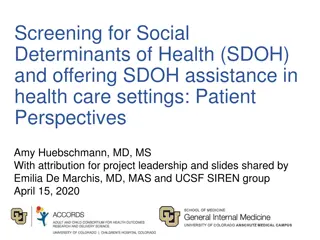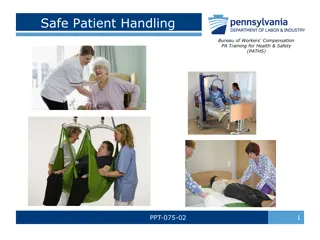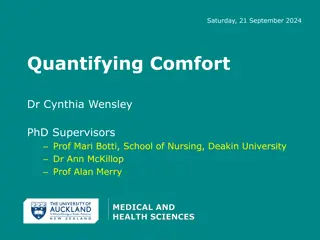Enhancing Patient Comfort and Satisfaction in Healthcare Settings through Creative Activities
Research emphasizes the impact of patient comfort on well-being in clinic and hospital environments. Patient satisfaction is linked to comfort levels, which can be improved through engaging activities. Strategies include allowing patients to bring personal comfort items, promoting a positive atmosphere, and providing creative activities for different age groups, such as sensory items for infants. Enhancing comfort directly contributes to improved morale, patient satisfaction, and positive feedback.
Download Presentation

Please find below an Image/Link to download the presentation.
The content on the website is provided AS IS for your information and personal use only. It may not be sold, licensed, or shared on other websites without obtaining consent from the author. Download presentation by click this link. If you encounter any issues during the download, it is possible that the publisher has removed the file from their server.
E N D
Presentation Transcript
Patient Comfort Dana Coleman & Bekah McDonald 4.27.2015
Reasoning: Over and over we have heard that the inevitable length of a clinic visit, or the lengthy lockdown of a stay at the hospital is difficult due to a level of discomfort in the patient and/or their families; mainly due to boredom; nothing to fill the time while inside . We opted to take time out to look in to some information and possible research regarding patient comfort and to see if there are any changes (small or large) that could be made in order to increase patient satisfaction within clinic visits and their inevitable in-patient stays.
Bits of research: Research states that patient comfort levels, whether in a clinic or hospital environment, significantly impact the patient s well-being. Most hospitals, including Shands (and subsequently UF Health) utilize patient satisfaction reports to optimize their efforts in regards to care and hospitality. Some hospitals encourage chronically ill patients to bring items with them that encourage their own comfortable environment; special blankets, cozy sweatpants, fuzzy socks, a favorite sweatshirt, etc. While hospitals are building fancy facilities and putting more art on the walls, research shows that doesn t matter as much to patients as comfort. It s increasingly recognized as equal to disease care Patients become more loyal to who treats them better (i.e. favorite restaurant)
patient is comfortable Cycle: directly related to patient satisfaction improved morale genuinely happy increased scores positive feedback
A different take on activities: Patient satisfaction is important. It allocates for higher quality of care and the ability to provide more for patients. However, due to budgets, which always dictate how much a hospital can do , clients cannot always receive things that will eliminate the boredom faced. Due to patient satisfaction directly correlating to their comfort levels: Patients and their families can direct their own activities OR if given the idea/interested/provided materials can be given remedies to cure the boredom faced. The following activity ideas are zero to no cost and can be suggested and/or implemented within the age group(s) specified. The latter activities/suggestions aim for the wishful thinking aspect of change.
For infants: Waiting (in its general definition) is not a skill infants can do well or should even be expected to do well. For times you can't avoid waiting with an infant, it's great to have some ideas. Sensory items are often captivating: a sampler of textured materials (cut up or purchase fabric swatches and put them on a book ring), bubbles, or board books with different textures inside. Learn a few simple interactive songs such as The Itsy-Bitsy Spider or 5 Little Monkeys. The more animated and interactive you are, the more engaged they will be. Consider bringing a puppet with you for long waits. A funny character or animal and silly voice can capture a young child's attention.
Things for toddlers: It's unreasonable to expect toddlers to wait long periods of time or have good behavior. One day they may play quietly while waiting, the next day a two minute wait will seem like two hours. Plan to be actively engaged with them during waiting times and use their natural curiosity to help. Go on a color or shape hunt; you can do this while seated or walking around. See how many purple items you can find in one minute or try to spot ten circles together. Work on coordination and have a few laughs playing "Simon (or mommy) Says" or come up with silly combinations such as "touch your nose to your elbow" or "touch your toes to your arm". Toddlers are actively developing social and emotional skills. Build on that by introducing feelings words and making different faces to match those words. Giggles will ensue as you show each other your best sad, happy, frustrated, surprised, or excited face. Play a version of hide-n-seek. Find a small item, even a coin will do. Hide it in your hands, under napkins or cups, and have your child guess where it is hiding. You can also create hide-n-seek bottles using an old water bottle and filling it with rice and a few small items. Seal the lid with hot glue and your child can find the items amidst the rice.
Pre-school Activities: Preschool aged children can participate in more complex and cognitive activities while waiting, beyond the standard children's menu and crayons given out at most restaurants. Play guessing games. "Twenty Questions" or "I Spy" can entertain for a long time. Both games help children develop and practice thinking and reasoning skills. Go on an alphabet hunt. Try to find all of the letters in the alphabet in the room, on a menu, on signs, wherever. Do this together or have a competition. Play favorites. Take turns naming categories like snacks, beverages, playground equipment, books, ice cream flavors, etc. and share your favorites. You can also ask each other questions like, "If you had to pick between chocolate and vanilla, which ice cream flavor would you pick?" Get creative and silly with your questions, such as, "If you had to turn into a farm animal, which animal would you be?" Explore categories further by choosing one and listing all the ideas you can think of together that fit; categories like girl's or boy's names, fruits, or animals work well. Practice physical development by pretending you are mirror images of each other. One person does the movement and the other person has to quickly imitate it. You can do this standing up or with smaller hand and face movements if you're seated.
School-aged: Older children have often developed their own strategies for dealing with waiting time, but too often it is through the use of electronics. Offer them a more meaningful alternative by engaging in a fun and educational activity together. Build their creativity and storytelling skills. Choose a person nearby or a photo of a person on a sign or in a magazine and create a story about them. Why is he there? What did he have for breakfast? Does he have pets? Where is he from? What is his biggest fear? His hobby? His job? If magazines are nearby, go through them and look at the advertisements. Cover up the brand or item name and try to guess what the ad is selling. You can do this with commercials too. The activity helps children think critically and become less susceptible to marketing. If you're in a store, use what's around you. Challenge children to find items for certain prices or teach them how to read labels and challenge them to find items with certain ingredients. (Teaching label reading and assessment is a great skill for nutrition as well.) Build your memory. Start with, "I went to the grocery store and bought " or, "I went camping and brought " Then take turns adding items. For younger children, add items alphabetically to support retention and memory. For example, your child says they bought apples, then you say you bought apples and bananas. Then your child says, they bought apples, bananas, coffee, and so on. Build vocabulary by finding unknown words or big words in magazines. Use context clues to guess what the words mean. Make up off-the-wall definitions too. Make sure you follow up with finding out what they mean (this is a good time to use technology - as a tool versus entertainment). Then challenge each other to use the word in sentences throughout the day.
Provided activity ideas: This picture is an activity kit . It is a Ziploc bag that contains multi-colored yarn, buttons, craft foam, construction paper, felt, etc. These bags are great at providing children with opportunities to pass the time with crafts. Not every bag has to be the same (to correlate to age range) but can be general. In terms of CF patients, these materials and bags can be taken home with the patient (suggested) or thrown away at the end of the visit, much like the gowns and gloves worn by the team.
Continued More costly. iPads, Xbox, PlayStation, etc. Can be checked-in/out by patient. Limited quantities. Activity-based websites and apps such as ________ provide school-aged patients the opportunity to interact and learn. These iPads or game systems can be cleaned and sterilized much like the equipment used in the clinic or hospital to decrease the spreading of germs and/or bacteria from CF patients.
Other ideas to amplify patient comfort: There are several other, simple ways to increase the comfort levels of patients that can be done quickly and without much effort. These include: speaking with them in a calm and comforting tone, being respectful, non- judgmental acceptance, listening to them, reassuring their wants and/or needs, and sitting to speak with them (in place of standing at the entrance of the room). Every attempt at providing quality care to patients will not go unnoticed. Patients notice the little things, whether good or bad. If each provider made the effort to deliver the best, heartfelt care possible, patients would find ultimate comfort in that.























